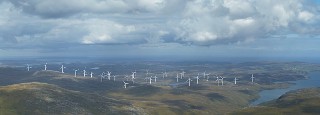
Mock up of Muaitheabhal windfarm
Helen McDade, head of policy for the JMT, said, “This approval comes before a sod has been turned on the original site. If developers can come back after the whole planning process, including a Public Local Inquiry, and significantly change their plans before a sod is turned with no real scrutiny, it makes a mockery of the planning process.
“There would seem to be worrying pointers about Scottish Government and planning policy that might be taken from this, alongside other planning approvals over the last months – including 59 turbines at Dorenell in Moray also festively approved, and the Beauly-Denny transmission line finally limping home with virtually no change from the scheme first lodged in 2006.
“The Scottish Government’s record shows that it approves almost a hundred percent of large onshore wind developments, regardless of the level of evidence and concern on issues such as the impact on key natural environment areas including wild land, damage to peatlands, and level of public objection – shown by the 20,000 objections to Beauly-Denny, for instance.
“This is even the case, as with Muaitheabhal, where significant adverse effects to nationally designated sites are accepted by the government’s own advisors. The Scottish Government Reporter for a Public Local Inquiry, examining a version of the Muaitheabhal scheme concluded, “that the wind farm would have significant adverse effects on scenic qualities for which the South Lewis, Harris and North Uist National Scenic Area was designated.” There is no evidence that the redesigned scheme is an improvement as there has been no further examination in public and the visualisation commissioned by the John Muir Trust shows that this will still have a huge impact on areas within the National Scenic Area (NSA). Over thirty turbines, taller than the London Eye, will be visible for Bheinn Mhor, within the NSA.
“Developers are using the planning process as a game, where they get as much as they can in the first round, then come back and back again. Perhaps it is time to accept that there is little point to Public Local Inquiries into wind developments when no amount of evidence seems to alter the inevitable decision. Tens of thousands of Scottish citizens have spent hundreds of thousands of hours and pounds bringing forward good evidence to Inquiries. Sadly, the results do not suggest this is a fair and democratic process. It is essential that we get a national energy strategy which shows a coherent plan for industrial wind generation whilst having some regard for protecting our children’s heritage.”
Due to the increased threat to wild land from development, the John Muir Trust is running a Wild Land Campaign, seeking a designation to protect the UK’s best wild land. To find out more visit the JMT website.
